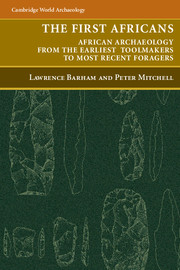Book contents
- Frontmatter
- Contents
- List of Figures and Tables
- Acknowledgements
- THE FIRST AFRICANS
- 1 Introducing the African Record
- 2 Frameworks in Space and Time
- 3 First Tool-Users and -Makers
- 4 Early Pleistocene Technologies and Societies
- 5 Mid-Pleistocene Foragers
- 6 Transitions and Origins
- 7 The Big Dry: The Archaeology of Marine Isotope Stages 4–2
- 8 Transitions: From the Pleistocene into the Holocene
- 9 Hunting, Gathering, Intensifying: The Mid-Holocene Record
- 10 Foragers in a World of Farmers
- 11 The Future of the First Africans' Past
- Notes
- Glossary
- References
- Index
4 - Early Pleistocene Technologies and Societies
Published online by Cambridge University Press: 05 June 2012
- Frontmatter
- Contents
- List of Figures and Tables
- Acknowledgements
- THE FIRST AFRICANS
- 1 Introducing the African Record
- 2 Frameworks in Space and Time
- 3 First Tool-Users and -Makers
- 4 Early Pleistocene Technologies and Societies
- 5 Mid-Pleistocene Foragers
- 6 Transitions and Origins
- 7 The Big Dry: The Archaeology of Marine Isotope Stages 4–2
- 8 Transitions: From the Pleistocene into the Holocene
- 9 Hunting, Gathering, Intensifying: The Mid-Holocene Record
- 10 Foragers in a World of Farmers
- 11 The Future of the First Africans' Past
- Notes
- Glossary
- References
- Index
Summary
The emergence and spread of stone tool technologies in the late Pliocene altered substantially the complex interplay between hominin behavioural and biological evolution. With the addition of cutting and pounding tools to their behavioural repertoire, some early hominins enhanced their dietary security and, ultimately, their reproductive success at a time of global climate change. In this chapter, we consider how a growing technological dependency manifested itself in the emergence of local traditions of tool-making, and explore the implications for the development of social mechanisms for the transmission of learned behaviours across generations. The time frame is restricted to the period 2.6–1.0 mya, during which changes in technology occurred that were built on Mode 1 foundations, including the development of bifacial cutting edges (Mode 2), the use of organic tools, and, possibly, the controlled use of fire. The overview ends with the onset of further disruptions to global climate cycles.
Our focus is not solely technological; we assess other aspects of the physiological and behavioural evolution of Homo that enabled this taxon to adapt to increased environmental variability and instability in the early Pleistocene. An arid peak 1.8–1.7 mya caused a further expansion of grasslands and coincides with the emergence of a new species – Homo erectus – characterised by an essentially modern postcranial skeleton with an elongated frame that enabled it to range long distances in increasingly open, arid environments.
- Type
- Chapter
- Information
- The First AfricansAfrican Archaeology from the Earliest Toolmakers to Most Recent Foragers, pp. 108 - 158Publisher: Cambridge University PressPrint publication year: 2008



